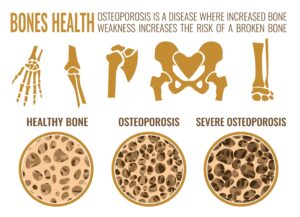Osteoporosis is a condition that results in weakened bones, making them fragile and more likely to break (fracture). It is often called a “silent disease” because it can progress over years without symptoms until a fracture occurs. Here is detailed information about osteoporosis for patients:
Understanding Osteoporosis
- Bone Density Loss: Osteoporosis occurs when the creation of new bone doesn’t keep up with the loss of old bone.
- Risk Factors: Factors that can increase the risk of developing osteoporosis include:
- ageing,
- hormonal changes (especially in postmenopausal women),
- family history,
- low body weight,
- long-term use of certain medications, such as prednisolone etc.,
- smoking,
- excessive alcohol consumption,
- and a sedentary lifestyle.
Symptoms
Osteoporosis itself does not cause symptoms in the early stages. Its primary manifestation is an increased risk of fractures. However, some late-stage symptoms can include:
- A stooped posture or loss of height over time due to vertebral (spine) fractures.
- Back pain is caused by fractured or collapsed vertebrae.
- Bone fractures occur more quickly than expected.
Diagnosis
- Bone Density Test (DEXA Scan): The most common way to diagnose osteoporosis is through a bone density test, which measures a fraction of one’s bone density compared to the healthy young adult standard (T-score).
Treatment and Management
- Medications: Various medications can help prevent bone loss and increase bone strength. These include:
- Bisphosphonates (for both men and women).
- Selective Estrogen Receptor Modulators (SERMs).
- Calcitonin, Parathyroid hormone (PTH) analogs, and Denosumab.
- Lifestyle Changes:
- Diet: Eating foods rich in calcium and vitamin D is essential for bone health.
- Exercise: Weight-bearing and muscle-strengthening exercises can help strengthen bones and muscles, improving balance and decreasing the risk of falls and fractures.
- Fall Prevention: Taking steps to minimize the risk of falls can help prevent fractures.
- Supplements: Calcium and vitamin D supplements may be recommended if enough from diet alone is challenging.
Prevention
- Healthy Lifestyle: Maintaining a healthy lifestyle, including a balanced diet rich in calcium and vitamin D, regular exercise, and avoiding smoking and excessive alcohol consumption, can help prevent osteoporosis.
- Bone Density Screening: Regular screening for bone density, especially for those at higher risk, can help detect osteoporosis early and prevent fractures.
Living with Osteoporosis
Living with osteoporosis means taking proactive steps to protect your bone health. This includes adhering to treatment plans, making lifestyle changes, and working closely with healthcare providers to monitor bone density and adjust treatments as necessary.
It’s also essential for patients to educate themselves about their condition, treatment options, and lifestyle modifications to manage their health effectively. Support groups and educational resources can also provide valuable information and support for individuals with osteoporosis.




